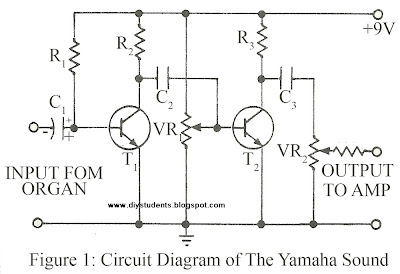No longer do you need to look wistful every time the guy on the TV rams home a power-chord on his big Yamaha DX synthesizer. With this ‘black box’ plugged in between your most non-descript organ and a good amplifier, you too can produce that very distinct but very familiar voice the zippy “Yamaha” sound.
The unit is nothing but a fuzz box commonly used for enlivening the droll sound of electric guitars. Acute distortion is created by passing the signal through a high-gain, 2-transistor amplifier where the 1 M-ohm preset control the working point of transistor T2, thus varying the degree of distortion or fuzz. The outcome is a sound laden with harmonics-the sound we want.
Circuit Diagram of Yamaha Sound:
Any ‘Plain-Jane’ organ can be used, but a simple 555 contraption works our best. Adjust the two preset for best simulation and constant input and output signal level. To produce the replica of the original, digitally-produced sound, too little distortion does no good at all, and too large a volume can knock up a demonic scream!
PARTS LIST
Resistors (all ¼-watt, ± 5% Carbon)R1 = 1 MΩ
R2 = 4.7 KΩ
R3 = 10 KΩ
VR1 = 1 MΩ
VR2 = 100 KΩ
Capacitors
C1 = 47 µF/12VC2 = 0.047 µF
C3 = 0.01 µF
Semiconductors
T1 = BC148BT2 = BC149

No comments:
Post a Comment